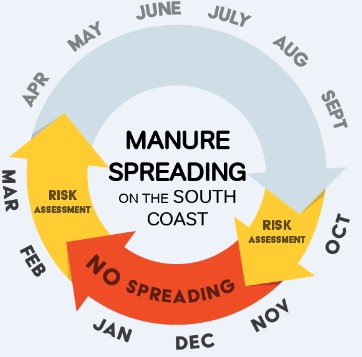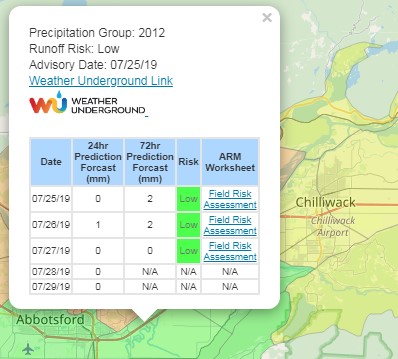Manure application and seasonal restrictions
As a farmer, manure is one of your greatest nutrient resources. When applied at the right time and at the right place, good manure management can improve soil quality and contribute to crop growth and yield. However, if not applied at the right time or right place, manure can be harmful to your farm operation and the environment.
The range of climates in B.C. present different challenges and environmental risks for manure spreading. As such, there are restrictions on manure spreading that apply only in the B.C. South Coast and there are restrictions that apply in all areas of B.C.
Requirements specific to the B.C. south coast
The spreading of manure in November, December and January is not permitted by regulation in B.C. During the shoulder months (October, February, and March), a risk assessment must be completed prior to spreading manure.

A risk assessment includes the following steps:
- Check the short-term weather forecast for precipitation
- Assess field conditions (crop cover, soil moisture, proximity to watercourses, setbacks)
- Document/Record & take appropriate steps
The BC Application Risk Management tool is available to complete a risk assessment.
The requirements for the B.C. South Coast apply to all areas designated as “high-precipitation areas”, which receive high amounts of precipitation from October to April.
- Wondering if your farm is in a high-precipitation area? Check out this map.
Requirements for all areas of B.C.
From April to September, basic requirements for manure spreading apply to all areas including the B.C. South Coast. The following requirements help you to maximize the benefits of manure application on your farm.
During the following conditions, applying manure will increase the risk of manure runoff into ditches and streams, leading to contamination of our surface water and other negative environmental impacts. Manure should not be applied during the following conditions:
- When the ground is frozen or snow-covered
- When soil is saturated with water
- During adverse weather conditions (strong winds and/or intense rainfall)
Soil is considered frozen when the top 5cm of ground is impenetrable with manually operated equipment. Snow-covered means at least 50% of the area is covered in 5cm of snow or ice.
For more information and guidelines and regulation related to manure application timing, please read the following sections of the new Agricultural Environmental Management Code of Practice.
Take action: The BC Application Risk Management (ARM) tool can be used to quickly assess risk on your own fields before manure spreading. Use the tool to get the most out of the manure you spread and ensure manure stays on your field.
If you have questions regarding spreading manure and you are located in the Interior, please refer to the frequently asked questions factsheet below.
Contact information
AgriService BC
Have a question? Call or email and ask for a soil, nutrient or waste management specialist to assist you.
Telephone: 1 888 221-7141
E-mail: AgriServiceBC@gov.bc.ca

